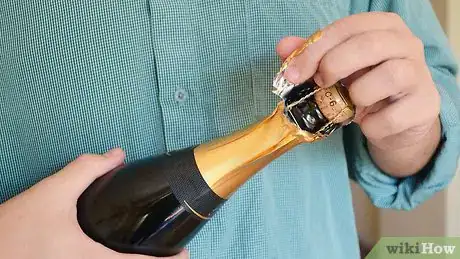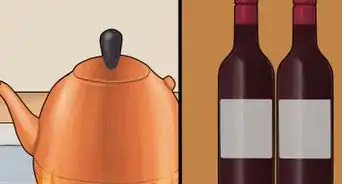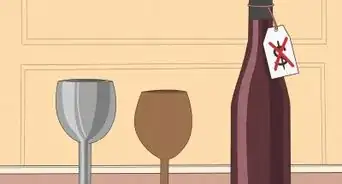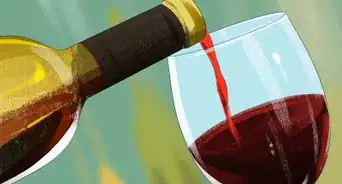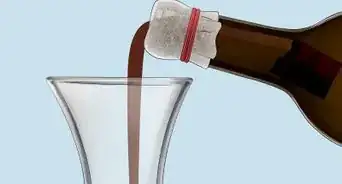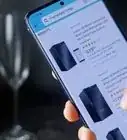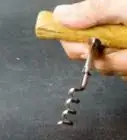This article was co-authored by wikiHow Staff. Our trained team of editors and researchers validate articles for accuracy and comprehensiveness. wikiHow's Content Management Team carefully monitors the work from our editorial staff to ensure that each article is backed by trusted research and meets our high quality standards.
There are 10 references cited in this article, which can be found at the bottom of the page.
wikiHow marks an article as reader-approved once it receives enough positive feedback. In this case, 90% of readers who voted found the article helpful, earning it our reader-approved status.
This article has been viewed 564,115 times.
Learn more...
Opening a champagne bottle is a powerful celebration ritual. The effect is grand, but the act of opening the bottle can be tricky if you haven't done it before. You'll need to twist the bottle, hold the cork, and gently push the cork out of the bottle. Make sure to keep a firm grip on the cork unless you want a champagne shower! Aim for a "sigh," not a "pop."[1]
Steps
Opening the Bottle
-
1Remove the foil and the metal cage. First, tear off the foil wrap that covers the cork. Then, untwist the wire loop to loosen the wire cage that protects the cork. Be gentle and take your time. Keep a thumb on the cork to head off an accidental pop.[2]
- Do not remove the wire cage until you are about to open the bottle! Otherwise, you may risk the bottle uncorking before you are ready. The cage is there to protect the cork.
-
2Hold the bottle properly. Grip the body of the bottle in your dominant hand at a 35°-45° angle and point it in a safe direction. Wedge the bulbous end of the cork deep into the palm of your non-dominant hand.[3]
- Support the base of the bottle against your hip. If you're holding the bottle in your right hand, use your right hip or the right side of your torso.[4]
- Consider holding the cork with a kitchen towel. This can help you apply friction, making it easier to catch and contain the cork as it pops out of the bottle. The towel may also protect against a spill.[5]
- If you don't hold the bottle in the correct angle aimed at a safe direction, you might end up hurting someone due to the sheer amount of pressure inside the bottle.
Advertisement -
3Twist the bottle and hold the cork. Slowly rotate the bottle back and forth with your dominant hand. Keep holding the cork steady with your non-dominant hand. As the cork turns, gradually increase the distance between your hands until your dominant hand is midway down the bottle.
-
4Pop the bottle. Decide what effect you're trying to achieve. If you're indoors or around a lot of people, make sure to take out the cork gently to avoid damage. If you want the dramatic effect of a champagne shower, then you can open the bottle with a mighty pop and send the cork flying high through the air. If you are opening champagne for a classy occasion: aim for a "sigh," not a "pop."
- Opening gently: Slow down your twisting toward the end, once the cork is almost out. Grasp the cork firmly. Press your thumb up from beneath the lip of the cork until it slides smoothly out of the bottle. Keep your grip on the cork, and "catch it" so that it doesn't fly away. Try to do it so gently that the cork doesn't make a popping sound.[6]
- Popping dramatically: Use your thumb to push the cork out from beneath the lip. Shake the bottle to stir up the carbonation, if you want a bit of a mess and a lot of added effect. Aim the bottle away from yourself, your friends, and any breakable items in the near vicinity. Avoid trying this method until you're comfortable opening a champagne bottle gently!
Following Champagne Etiquette
-
1Chill the bottle before opening. Store in the refrigerator, a cooler, or an ice bucket. Give it at least a few hours to ensure that the contents are completely chilled. Not only will this improve the taste, but it will make the bottle less likely to spray champagne everywhere.[7]
-
2Open carefully in formal settings. Keep a firm grip on the cork so that it doesn't fly away unexpectedly. Slowly twist the bottle—not the cork—until the cork is almost out of the bottle. Listen for the almost inaudible "sigh" of the cork coming loose.[8] Then, pull it out delicately using entire palm of your hand. Hold the cork over the opened bottle for a few seconds to make sure that the foam doesn't bubble over.[9]
- If you are serving champagne as a waiter or a caterer, it is usually considered proper etiquette to open the bottle as unobtrusively as possible. Do not spray, and do not let the cork fly. Practice until you can do it without so much as a "pop."
-
3Avoid shaking the bottle. Champagne is a carbonated beverage stored under pressure. When you shake the bottle, you build up that pressure to dangerous levels. Opening a highly-pressurized champagne bottle will unleash a mighty spout of champagne and send the cork flying forward at high velocity.[10]
- If you do accidentally shake the bottle, let it sit still for an hour or two so that the contents have time to settle. The CO2 will absorb back into the drink more quickly if the champagne is cold.[11]
-
4Pour slowly. Champagne is carbonated, and the bubbly liquid rises quickly when poured into a glass. Don't spill and waste champagne – especially if you are serving someone else![12]
- Hold the glass upright. Do not slant it to pour.
- Fill a third of each glass with champagne. Then, top up the servings once you've poured a bit for everybody.[13]
- Do not touch the spout onto the rim of anyone's glass. Champagne is often stored in cellars, and in some circles it is considered poor etiquette to risk dirtying someone's glass.
Expert Interview

Thanks for reading our article! If you'd like to learn more about champagne, check out our in-depth interview with Murphy Perng.
References
- ↑ https://www.thekitchn.com/how-to-open-a-bottle-of-champagne-cooking-lessons-from-the-kitchn-215827
- ↑ http://www.wineintro.com/champagne/open/
- ↑ http://www.realsimple.com/food-recipes/shopping-storing/beverages/open-bottle-sparkling-wine
- ↑ http://www.foodnetwork.com/how-to/photos/how-to-open-a-champagne-bottle.html
- ↑ https://www.thekitchn.com/how-to-open-a-bottle-of-champagne-cooking-lessons-from-the-kitchn-215827
- ↑ http://www.refinery29.com/how-to-open-champagne
- ↑ http://drinks.seriouseats.com/2014/01/cocktail-science-what-is-carbonation-how-to-carbonate-soda-better-carbon-dioxide-facts.html
- ↑ http://blog.vinfolio.com/2014/12/11/pro-tips-for-drinking-champagne/
- ↑ http://www.etiquettescholar.com/dining_etiquette/gourmet_guide/drink/champagne.html
- ↑ http://drinks.seriouseats.com/2014/01/cocktail-science-what-is-carbonation-how-to-carbonate-soda-better-carbon-dioxide-facts.html
- ↑ http://physics.stackexchange.com/questions/1302/why-cant-co-2-mix-back-with-the-liquid-after-a-soda-bottle-has-been-shaken
- ↑ http://www.etiquettescholar.com/dining_etiquette/gourmet_guide/drink/champagne.html
- ↑ http://www.refinery29.com/champagne-facts-etiquette#slide-2
Expert Q&A
Did you know you can get expert answers for this article?
Unlock expert answers by supporting wikiHow
-
QuestionHow many glasses of champagne make a bottle?
 Murphy PerngMurphy Perng is a Wine Consultant and the Founder and Host of Matter of Wine, a business that produces educational wine events, including team-building experiences, networking events, and private parties. Based in Los Angeles, California, Murphy has served as a Wine Educator for clients such as Google, Buzzfeed, Tiktok, Snapchat, and Equinox and been featured on National Geographic and The Somm Journal. Murphy possesses her WSET (Wine & Spirit Education Trust) Level 3 Advanced Certification.
Murphy PerngMurphy Perng is a Wine Consultant and the Founder and Host of Matter of Wine, a business that produces educational wine events, including team-building experiences, networking events, and private parties. Based in Los Angeles, California, Murphy has served as a Wine Educator for clients such as Google, Buzzfeed, Tiktok, Snapchat, and Equinox and been featured on National Geographic and The Somm Journal. Murphy possesses her WSET (Wine & Spirit Education Trust) Level 3 Advanced Certification.
Certified Wine Consultant
-
QuestionHow do you open champagne without it exploding?
 Christopher LuccheseChristopher Lucchese is a Certified Sommelier affiliated with Home Somm, a Los Angeles, California-based business that does private wine tastings, education and paired wine dinners. Christopher was also a Sommelier for Michael Mina's Bourbon Steak, a Michelin-rated restaurant for three years. He is a Level 4 Diploma Student with the WSET (Wine & Spirit Education Trust). He is also a Certified Sommelier by the Court of Master Sommeliers and has trained with the Wine Scholar Guild and The Culinary Institute of America. He took two semesters at UC Davis for winemaking, viticulture and enology.
Christopher LuccheseChristopher Lucchese is a Certified Sommelier affiliated with Home Somm, a Los Angeles, California-based business that does private wine tastings, education and paired wine dinners. Christopher was also a Sommelier for Michael Mina's Bourbon Steak, a Michelin-rated restaurant for three years. He is a Level 4 Diploma Student with the WSET (Wine & Spirit Education Trust). He is also a Certified Sommelier by the Court of Master Sommeliers and has trained with the Wine Scholar Guild and The Culinary Institute of America. He took two semesters at UC Davis for winemaking, viticulture and enology.
Certified Sommelier
-
QuestionHow much champagne should you consume in an evening?
 Community AnswerIf you are looking to make a good impression, don't drink more than 2-3 glasses of champagne over the course of the evening. If you are driving, limit yourself to one.
Community AnswerIf you are looking to make a good impression, don't drink more than 2-3 glasses of champagne over the course of the evening. If you are driving, limit yourself to one.
Warnings
- Do not pry the cork or use a corkscrew to open the bottle.⧼thumbs_response⧽
- Do not let go of the cork as you pull it out. It can shoot out at high velocity. If the cork is aimed in the wrong direction, it might break a valuable object or seriously hurt somebody. Do not point the bottle at yourself or others while opening.⧼thumbs_response⧽
- Do not let go of the body of the bottle as the cork is coming out. The bottle can shoot off towards the ground and break.⧼thumbs_response⧽
- Do NOT attempt to open a bottle which is not completely chilled. A warm or room-temperature bottle is more likely to pop and spray all over the place. Make sure you chill your champagne bottle before opening it.⧼thumbs_response⧽
Things You'll Need
- Chilled champagne
- Kitchen towel
- Champagne glasses
About This Article
To open a champagne bottle, start by taking off the foil that covers the cork. Then loosen the metal cage that holds the cork in the bottle by folding out the tab and twisting it counterclockwise. Remove the cage and discard it. Then cover the cork with a dish towel. Pick up the bottle, making sure that cork is pointed in a safe direction away from other people or breakables. Hold the cork, covered by the towel, with one hand, and the base of the bottle in the other. Gently twist the bottle - not the cork - back and forth, while holding the cork firmly. Do not twist or pull the cork, which can cause it to break off. As you twist the bottle, you should feel the cork start to slide out of the bottle. Keep twisting the bottle gently until the cork makes a small pop and comes out of the bottle, making sure that your hand is covering the cork at all times. Your champagne will stay more bubbly, and be less likely to overflow if you go slowly. Wait a few moments for the champagne to settle, then pour a small amount into each person’s glass. Once the fizz from the initial pour has gone down, continue pouring into each glass until everyone has been served. For a more dramatic celebratory experience, you can send the cork flying by pushing it away from the bottle with your thumbs once it is nearly out of the bottle. If you do this, make sure you’re outside and pointing the bottle a safe direction, and expect champagne to foam out of the top of the bottle after the cork flies away. If you want to learn proper champagne etiquette, such as how to chill or pour it, keep reading!
